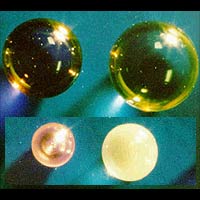Solar & Battery Fan DIY STEM Kit
$9.99$6.50
Posted on: Oct 8, 2003

There's a new glass in town. The glass, developed with the help of a unique NASA levitator facility, is available for numerous commercial applications including lasers and optical communications.
"We have patented a family of new glasses and have established processes for making and using them in practical applications," said Dr. Richard (Rick) Weber, director of the Glass Products Division of Containerless Research Inc., the small company that invented and produces the glass in Evanston, Ill. "We're already making commercial quantities of glass rods and plates for use in lasers," he said.
REAl Glass™ — made from Rare Earth oxides, Aluminum oxide and small amounts of silicon dioxide — has unique properties that were identified using both the company's containerless processing techniques and a NASA ground-based research facility.
As part of a NASA research grant for a proposed International Space Station flight experiment, Weber conducted research in the Electrostatic Levitator at NASA's Marshall Space Flight Center in Huntsville, Ala. The levitator, where molten spheres of glowing material float with no visible means of support or containment, is one of the nation's few facilities where scientists can process materials without using contaminating containers.
"This shows how basic NASA research can lead to innovative materials and new products that can benefit everybody," said Dr. Michael Wargo, Enterprise Scientist for materials science in NASA's Office of Biological and Physical Research in Washington.
Containerless Research's development of applications and new products for lasers, optical communications, and surgical lasers is supported by grants from the National Science Foundation and the Air Force Office of Scientific Research.
"The development of REAl Glass™ shows how the Small Business Innovation Research (SBIR) program works by building on good ideas that come from basic research and helping small businesses grow into commercial manufacturers of innovative products," said Dr. Winslow Sargeant, who directs the National Science Foundation SBIR Commercialization Program for devices. "We are working with Containerless Research Inc. by supporting product research and development that can help them grow the business and continue to create new products and new jobs," Sargeant explained.
REAl Glass™ has qualities useful for creating materials for demanding optical applications. "We've taken many of the best qualities of the current materials and created a new glass that can be produced inexpensively," Weber said.
One of the most promising uses of the glass is for lasers. Whether it is a power laser for cutting metal for car bodies or a medical laser used for surgery, the "heart" of lasers is the gain medium, which is where REAl Glass™ can be used. This critical component increases or amplifies light, resulting in an intense, highly concentrated beam capable of precisely cutting metal parts or surgically removing or repairing human tissue.
"Most surgical lasers now use expensive single crystals, which limit the range of operating wavelength to very narrow bands," explained Weber. "REAl Glass™ would provide tunability, which can give more control over surgical procedures, an important factor in different types of surgery and for different skin types. Our glass can provide efficient power lasers and expand coverage to new wavelengths," he said.
REAl Glass™ also provides a medium for next-generation optical communications devices that need to be small, low-cost and powerful to provide fiber for home connections for broadband Internet. The company can customize the glass composition for these uses. The family of REAl Glass™ materials is patented under U.S. Patent No. 6,482,758 issued Nov. 19, 2002, and is only available from Containerless Research Inc., or under license.
 'I beseech you to take interest in these sacred domains so expressively called laboratories. Ask that there be more and that they be adorned for these are the temples of the future, wealth and well-being. It is here that humanity will grow, strengthen and improve. Here, humanity will learn to read progress and individual harmony in the works of nature, while humanity's own works are all too often those of barbarism, fanaticism and destruction.'
'I beseech you to take interest in these sacred domains so expressively called laboratories. Ask that there be more and that they be adorned for these are the temples of the future, wealth and well-being. It is here that humanity will grow, strengthen and improve. Here, humanity will learn to read progress and individual harmony in the works of nature, while humanity's own works are all too often those of barbarism, fanaticism and destruction.'